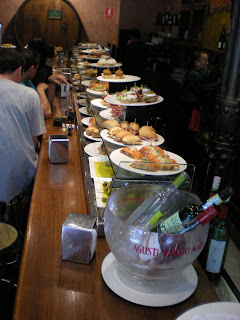I know this may be boring, still, I thought I'd let you guys know the variety of paellas here in Valencia. These are from a paella restaurant called Marisco thus the name is incorporated into may of the recipe names. I've been to other restaurants with similar menus so I felt this was fairly representative. I'll try to supply more pics of the prepared dishes late.
Fideua De Marisco - this paella is made with thin pasta rather than rice. I've never tried it but I've seen it. It contains mussels, prawns, squid, sweet red bell pepper, artichoke heart and green peas
Paella de Arroz Negro - Black rice Paella made with squid ink that causes the rice to appear black. It contains squid, mussels, prawns, squid ink, artichoke hearts and peas
Paella Valencia - This is the actual paella most people HERE think of as being the local recipe. I had a small dish of this from a vendor in the street but I don't think of this when I think of paella. It contains chicken, green beans, carob beans and sweet red or green bell peppers
Paella De Marisco Pelado - peeled seafood including squid, prawns, mussels, sweet peppers and green peas
Paella Mixta - chicken, spare ribs, prawns, mussels, sweet pepper and green peas
Paella De Marisco - scampi, squid, prawns, mussels, green peas, red bell pepper
As you can see there is a sorta typical combination of ingredients. Interestingly I never see onion listed as an ingredient. The first time I remember eating anything like this is when my grandmother (Abuela Argelia) would make what we called yellow rice ad chicken (arroz con pollo). She would combine the rice and chicken in a baking pan and cook it in the oven. When it was almost done she would add roasted red pepper and green peas on top and then pop it back in the oven to finish. I guess it was basically a chicken paella.


 This is the restaurant by my school that has the fancy tapas I mentioned in an earlier post. The plates of Tapas are set out on the bar and you just take whatever you want. They constantly replace items and add new stuff. When you're done, the waiter adds up your toothpicks and that's how they know what to charge you.
This is the restaurant by my school that has the fancy tapas I mentioned in an earlier post. The plates of Tapas are set out on the bar and you just take whatever you want. They constantly replace items and add new stuff. When you're done, the waiter adds up your toothpicks and that's how they know what to charge you.













